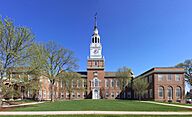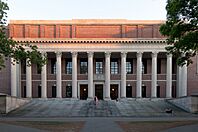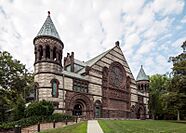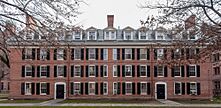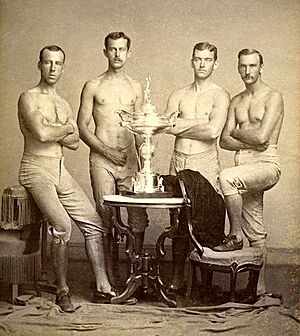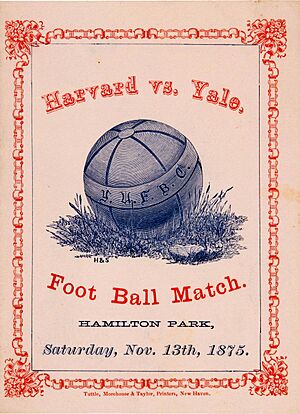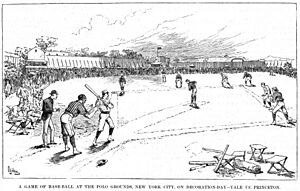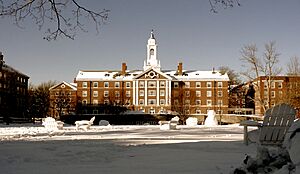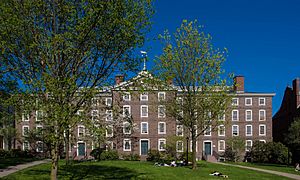Ivy League facts for kids
 |
|
| Association | NCAA |
|---|---|
| Founded | 1954 |
| Commissioner | Robin Harris (since 2009) |
| Sports fielded |
|
| Division | Division I |
| Subdivision | FCS |
| No. of teams | 8 |
| Headquarters | Princeton, New Jersey, U.S. |
| Region | Northeast |
| Locations | |
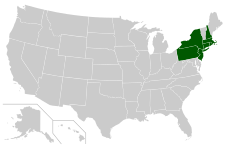
Home states of the eight Ivy League universities |
|
The Ivy League is a special group of eight private universities in the Northeastern United States. It's known for its sports teams, which compete in NCAA Division I. In football, they play in the Football Championship Subdivision (FCS).
Beyond sports, the name "Ivy League" also refers to these eight schools as some of the best in the world. They are famous for their excellent academics, very tough admissions, and a history of attracting top students. The term "Ivy League" was first used in 1933 and became official in 1954 when the athletic conference was formed. Sometimes, people call them the "Ancient Eight" because most of them are very old.
The eight universities in the Ivy League are Brown University, Columbia University, Cornell University, Dartmouth College, Harvard University, University of Pennsylvania, Princeton University, and Yale University. The main office for the Ivy League is in Princeton, New Jersey. Most of these schools were started a long time ago, during the time of the Thirteen Colonies. Cornell is the only exception, founded later.
Contents
About the Ivy League Schools
Ivy League schools are considered some of the most respected universities globally. All eight are usually ranked among the top national universities. For example, a member of the Ivy League has been named the best national university every year since 2001.
These universities have very large financial funds, called financial endowments. These funds help them provide great academic programs, financial aid for students, and support for research. Harvard University has the largest financial fund of any school in the world.
The Ivy League is like other groups of famous universities around the world. Examples include Oxbridge in England and the C9 League in China.
Ivy League Members
Here are the eight universities that make up the Ivy League:
| Institution | Location | Undergraduates | Postgraduates | Endowment (In $ Billions) |
Academic Staff | Year Founded | Team Name | Colors |
|---|---|---|---|---|---|---|---|---|
| Brown University | Providence, RI | 7,349 | 3,347 | $6.20 | 736 | 1764 | Bears | |
| Columbia University | New York, NY | 6,716 | 21,987 | $13.64 | 4,370 | 1754 | Lions | |
| Cornell University | Ithaca, NY | 15,503 | 10,097 | $10.04 | 2,908 | 1865 | Big Red | |
| Dartmouth College | Hanover, NH | 4,556 | 2,205 | $7.93 | 943 | 1769 | Big Green | |
| Harvard University | Cambridge, MA | 7,153 | 14,495 | $49.50 | 4,671 | 1636 | Crimson | |
| University of Pennsylvania | Philadelphia, PA | 9,962 | 13,469 | $20.96 | 4,464 | 1740 | Quakers | |
| Princeton University | Princeton, NJ | 5,321 | 3,157 | $34.06 | 1,172 | 1746 | Tigers | |
| Yale University | New Haven, CT | 6,536 | 8,031 | $40.75 | 4,140 | 1701 | Bulldogs |
Former Sports Members
Before the 2000s, some other schools competed with Ivy League teams in certain sports. The United States Military Academy (Army) and the United States Naval Academy (Navy) were part of the Ivy League in many sports. They even won Ivy League championships. Both schools later left to join the Patriot League.
History of the Ivy League
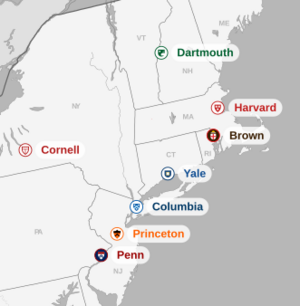
How the Schools Started
Most of the Ivy League schools are "Colonial Colleges." This means they were founded before the American Revolution. Cornell is the only one that started after the American Civil War. These early colleges were the main places for higher learning in the northern and middle colonies of British America.
Many of these schools were started with ties to religious groups. For example, Harvard, Yale, and Dartmouth were linked to Congregationalists. Princeton was connected to Presbyterians, and Brown was founded by Baptists. Columbia was started by Anglicans. Penn and Cornell were not officially tied to any religion. Today, all Ivy League schools are private and not connected to any religion.
Where the Name "Ivy" Came From
The name "Ivy" comes from an old tradition. In the 1800s, many colleges had a "class day" ceremony where students would plant ivy at a university building. This was a common practice at schools like Penn and Yale. Princeton even had an "Ivy Club" founded in 1879.
The first time "Ivy" was used for a group of colleges was by sportswriter Stanley Woodward in 1933. He wrote about "our eastern ivy colleges" playing football. The term "Ivy League" officially appeared in 1935. It was used to describe older colleges in the Northeast, known for their long history in sports.
Some people mistakenly think the name comes from the Roman numeral for four (IV), believing there were originally four members. However, this is a myth. The name truly comes from the ivy-planting traditions.
History of Ivy League Sports
Ivy League schools have been competing in sports for a very long time. The first formal athletic league in the U.S. was created in 1870. It was called the Rowing Association of American Colleges (RAAC) and included only Ivy League universities.
The first rugby football game between Harvard and Yale was in 1875. In 1881, Penn, Harvard, Princeton, and Columbia formed the Intercollegiate Cricket Association. Cornell later joined. In 1895, Cornell, Columbia, and Penn started the Intercollegiate Rowing Association, which is the oldest college sports group in the U.S. A basketball league was formed in 1902, including Columbia, Cornell, Harvard, Yale, and Princeton.
In 1906, the National Collegiate Athletic Association (NCAA) was formed to create rules for football. Many Ivy League schools were among its first members.
Even though Ivy League schools played against each other for decades, the official Ivy League athletic conference wasn't formed until later. In 1930, Columbia, Cornell, Dartmouth, Penn, Princeton, and Yale created the Eastern Intercollegiate Baseball League. Harvard and Brown joined later.
In 1945, the presidents of the eight schools signed the first Ivy Group Agreement. This agreement set rules for their football teams, including that athletic ability would not affect admissions. This meant no special scholarships just for athletes.
In 1954, this agreement was expanded to include all sports. This is when the Ivy League officially became the athletic conference we know today. The Ivy League is the oldest basketball conference in Division I.
Many Ivy League schools used to be only for men. Cornell was the first to allow both men and women from its start in 1865. Columbia was the last to become coeducational in 1983. Before this, many Ivy schools had social ties with nearby women's colleges, like the Seven Sisters.
The Ivy League was the first sports conference to stop all athletic competitions in March 2020 because of the COVID-19 pandemic. This meant many sports seasons were canceled. Regular sports competitions started again in the fall of 2021.
Academics and Admissions
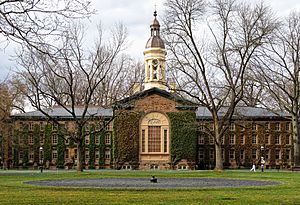
Ivy League schools are very hard to get into. Most of them accept less than 6% of applicants. Students come from all over the world, but many are from the Northeastern United States. In 2021, all eight Ivy League schools received a record number of applications.
There have been discussions about how Ivy League schools admit students. In 2023, the U.S. Supreme Court ruled that colleges cannot use a student's race as a factor in admissions. This decision changed how universities, including the Ivy League, approach student diversity.
Prestige and Rankings
Ivy League schools are consistently ranked very high by different groups. They are almost always in the top 20 national universities according to U.S. News & World Report.
The universities also work together. The Ivy Council is a student group with representatives from each school that meets twice a year. The presidents of all eight universities also meet to discuss common goals. There's also an exchange program that lets students take classes at other Ivy League schools or other top universities like MIT and Stanford.
History of Diversity
Racial Integration
Ivy League universities have a complex history with racial diversity. Many of them were founded during the time of slavery in the U.S. In recent years, some universities like Brown and Yale have looked into their past ties to slavery. They found that enslaved Black people lived on campus and helped care for students and professors.
Early Black students did attend Ivy League schools, but they didn't always receive degrees. For example, some Black students studied at Princeton as early as 1774, but no Black students graduated from Princeton until the mid-1900s. Cornell was one of the most open Ivy League schools from the start, admitting students of any race and gender.
In the early 1900s, admitting Black students was often controversial. Harvard admitted its first Black student in 1847, which caused protests. Brown seemed to refuse Black students before the Civil War. Princeton was the last to integrate, admitting its first Black student in the 1940s through a Navy program.
By the mid-1900s, some students and alumni pushed for more racial integration. The 1954 Supreme Court decision in Brown v. Board of Education did not directly apply to private universities. However, a later ruling in 1976 made it illegal for private schools to discriminate based on race. By the 1960s, Ivy League schools started actively trying to recruit more Black students.
As more Black students joined Ivy League campuses, student activism grew during the Civil Rights Movement. Students at Cornell, Yale, and Brown protested for more Black faculty, Black studies programs, and increased admission of students of color.
In the 21st century, the number of Black students at Ivy League schools has continued to rise. From 2006 to 2018, there was about a 50% increase in Black student admissions. However, the 2023 Supreme Court ruling against race-conscious admissions has changed how universities can pursue diversity.
Ivy League universities have also removed or renamed campus landmarks due to their historical ties to racism. For example, Princeton removed Woodrow Wilson's name from a building because of his racist views.
Fashion and Lifestyle
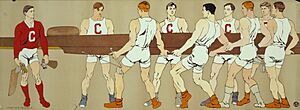
The Ivy League has influenced fashion trends like "Ivy League style" and "preppy style." These styles were popular in the 1950s and are still seen today. Stores like J. Press and Brooks Brothers are known for this look.
Preppy fashion often includes clothes for traditional activities like equestrian, sailing, and rowing. Brands like L.L. Bean and Lacoste became part of this style.
While often linked to wealthy white students, the Ivy League style also became popular in Black communities during the Civil Rights era. This led to a new style called "Black Ivy." Today, these styles are known as "Classic American style."
Social Elitism
The Ivy League is sometimes seen as connected to the very wealthy and upper-class families in the Northeast. While many students do come from these backgrounds, the universities are working to increase diversity by offering more financial aid to students from lower and middle-income families.
Despite these efforts, the number of students from less wealthy families remains low. The term "Ivy League" has historically been linked to academic excellence but also to social elitism.
However, many U.S. presidents have attended Ivy League schools. Since 1989, every president except Joe Biden has had some Ivy League education.
U.S. Presidents from the Ivy League
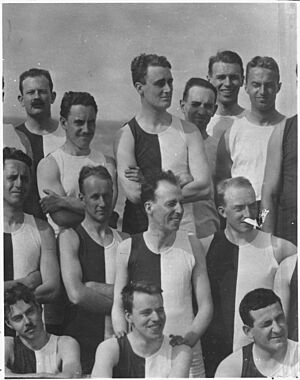
Sixteen of the 45 people who have been President of the United States graduated from an Ivy League university. Eight presidents have degrees from Harvard, five from Yale, three from Columbia, two from Princeton, and one from Penn.
Here are some of the presidents who attended Ivy League schools:
| President | School(s) | Graduation year |
|---|---|---|
| John Adams | Harvard University | 1755 |
| James Madison | Princeton University | 1771 |
| John Quincy Adams | Harvard University | 1787 |
| William Henry Harrison | University of Pennsylvania | (withdrew, class of 1793) |
| Rutherford B. Hayes | Harvard Law School | 1845 |
| Theodore Roosevelt | Harvard University Columbia Law School |
1880 (withdrew, class of 1882) |
| William Howard Taft | Yale University | 1878 |
| Woodrow Wilson | Princeton University | 1879 |
| Franklin D. Roosevelt | Harvard University Columbia Law School |
1903 (withdrew, class of 1907) |
| John F. Kennedy | Princeton University Harvard University |
(withdrew) 1940 |
| Gerald Ford | Yale Law School | 1941 |
| George H. W. Bush | Yale University | 1948 |
| Bill Clinton | Yale Law School | 1973 |
| George W. Bush | Yale University Harvard Business School |
1968 1975 |
| Barack Obama | Columbia University Harvard Law School |
1983 1991 |
| Donald Trump | University of Pennsylvania | 1968 |
Sports and Competition
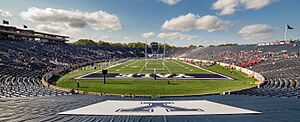
The Ivy League has champions in 16 men's and 16 women's sports. In some sports, like ice hockey, Ivy teams also play in other leagues. The Ivy League was the last Division I basketball conference to start a postseason tournament. The first tournaments for men and women were held in 2017.
Unlike most college sports conferences, the Ivy League does not give out athletic scholarships. All scholarships are based on financial need. Also, athletes cannot "redshirt" (take a year off from playing to extend their eligibility). Graduate students cannot play in Ivy League sports either, with a few rare exceptions.
In the past, before athletic scholarships became common, Ivy League teams were very successful in many sports. Princeton won 26 national championships in college football, and Yale won 18. These numbers are higher than many other famous football programs.
Since 1982, Ivy League football teams have competed in the NCAA Division I Football Championship Subdivision (FCS). For a long time, the Ivy League did not participate in the FCS playoffs because of concerns about how the long season would affect academics. However, starting in 2025, the Ivy League champion will automatically qualify for the FCS playoffs.
Sports Teams
The Ivy League offers a wide range of sports. Here are the sports sponsored by the Ivy League:
| Sport | Men's | Women's |
|---|---|---|
| Baseball | 8 | – |
| Basketball | 8 | 8 |
| Cross-country | 8 | 8 |
| Fencing | 6 | 7 |
| Field hockey | – | 8 |
| Football | 8 | – |
| Golf | 8 | 7 |
| Ice hockey | 6 | 6 |
| Lacrosse | 7 | 8 |
| Rowing | 8 | 7 |
| Soccer | 8 | 8 |
| Softball | – | 8 |
| Squash | 8 | 8 |
| Swimming and diving | 8 | 8 |
| Tennis | 8 | 8 |
| Track and field (indoor) | 8 | 8 |
| Track and field (outdoor) | 8 | 8 |
| Volleyball | – | 8 |
| Wrestling | 6 | – |
Sports Rivalries
There are many strong rivalries within the Ivy League. For example, Princeton and Penn have a long-standing rivalry in men's basketball. These two teams have won most of the Ivy League basketball titles.
Other rivalries include Cornell and Harvard in hockey, and Harvard and Princeton in swimming. In men's lacrosse, Cornell and Princeton are big rivals. Harvard and Yale have a famous rivalry in football and crew, known as "The Game" for football.
The Yale–Princeton football rivalry is one of the longest-running in the nation. These games used to be played at neutral sites and often decided the national championship in the early days of college football. They helped make college sports popular.
Other "Ivies"
The term "Ivy" is sometimes used to describe other colleges that are similar to the Ivy League in quality or prestige. These include:
- Little Ivies: Smaller liberal arts colleges in the Northeast.
- Public Ivies: Public universities that offer an education similar to the Ivy League.
- Hidden Ivies: Schools that are highly selective but less famous than the traditional Ivies.
- Black Ivies: Historically Black colleges and universities that are considered highly prestigious.
Ivy Plus Group
The informal term "Ivy Plus" refers to the eight Ivy League schools plus four other top universities: MIT, Stanford University, Duke University, and University of Chicago. Sometimes Johns Hopkins University is also included. These schools are grouped together because they often work together on academic programs and share resources.
See also
 In Spanish: Ivy League para niños
In Spanish: Ivy League para niños
- Big Three—an athletic rivalry between Harvard, Yale, and Princeton.
- List of Ivy League medical schools—schools of the Ivy League universities that offer medical education.
- List of Ivy League law schools—schools of the Ivy League universities that offer various law degrees.
- List of Ivy League business schools—schools of the Ivy League universities that offer various business degrees, especially the MBA.
- List of Ivy League public policy schools—schools of the Ivy League universities that offer public policy or public administration degrees.
- Black Ivy League—informal list of private historically black colleges and universities that have historically been seen as the African American equivalent to the Ivy League
- Little Ivies—private liberal arts colleges that historically have had the same social prestige and similar large financial endowments as the Ivy league.
- Public Ivy—public colleges & universities that are perceived to provide an education equal to the Ivy League.
- Seven Sisters—seven liberal arts colleges previously open to only women with historical affiliations to the Ivy League.







